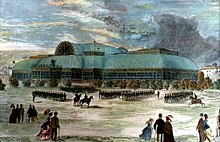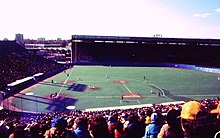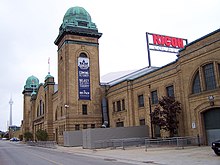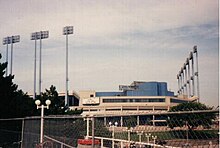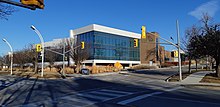Exhibition Place
The district's facilities are used year-round for exhibitions, trade shows, public and private functions, and sporting events.
Exhibition Place is a rectangular site located length-wise along the north shoreline of Lake Ontario to the west of downtown Toronto.
There is a large open paved area in the southern central section, which is used for parking and the temporary amusements of the Canadian National Exhibition (CNE).
The area was an important portage route for Native Americans, and the French wanted to capture their trade before they reached British posts to the south.
In its place was built the fourth Grandstand, a massive concrete construction and monumental cantilevered steel roof was a sharp contrast to the other buildings around it.
The City planned to charge rent to the midway's operator, Conklin Shows, which chose to tear down the buildings instead and set up temporary rides each year for the CNE.
The only two respondents, Ripley Entertainment and Oceanus Holdings, suggested that they would be interested provided the location was closer downtown or had better transit access and parking.
The Enercare Centre and Coliseum buildings were used for indoor sports, temporary facilities for beach volleyball were built south of BMO Field and a watercourse laid out on Lake Ontario.
However, on October 26, 2005, the City of Toronto approved the construction of a 20,000 seat soccer stadium (BMO Field) on Exhibition Place land.
It initially housed 22,000 people, but was expanded over the years to a maximum of 54,000 in order to accommodate the additional seating required for major professional sports teams who made CNE Grandstand their home.
Similarly, many well-known musical acts made an appearance at the venue, ranging from Duke Ellington, Guy Lombardo, Benny Goodman, The Beach Boys (appearing there 11 times between 1974 and 1990), The Monkees, Sonny & Cher, to Melissa Etheridge, The Who, Simon & Garfunkel, Sinéad O'Connor, Billy Idol, Nine Inch Nails and Tina Turner.
The Blue Jays and Argos left the open-air Exhibition Stadium for the retractable roofed Skydome (now, the Rogers Centre) in 1989.
For many people attending the CNE, the building hosted their first encounters with such technologies as colour television, transistor radios or home computers.
It also became the place where people would expect to see the latest models of various consumer goods, ranging from vacuum cleaners to kitchen appliances.
The building's stark modernist architecture, made up of large white forms, a vast flat roof and harsh angles, suited its futurist themes.
The Food Building's Modernist features include its windowless walls, white pre-cast panels with a broomed finish on the face, and troweled borders.
[26] It was designed by architect Peter Dickinson and architectural firm Page + Steele Inc.[27] It was renamed in honour of a royal visit.
When he died in 1901, the York Pioneers renamed it "The Scadding Cabin", in honour of this son of the original owner, who had also been a past president of their society.
It is a squat, two-storey log cabin with low ceilings, designed to retain the heat from the fire in winter close to its occupants.
Inspired by the Hollywood Bowl, the Art Deco-styled Bandshell on the CNE grounds was built in 1936 according to designs prepared by the Toronto architectural firm of Craig and Madill.
[29] It is situated on the west side of the grounds, and over the years has been host to many famous acts, including Guy Lombardo, Louis Armstrong, The Guess Who, and Joni Mitchell.
More recently the likes of Susan Aglukark, Moxy Früvous, and Bob Newhart have played the open air venue.
The original gateway was erected in 1895 and was superseded by a more permanent, ornate Beaux-Arts style triumphal arch built in 1910, and officially re-opened by Lord Dufferin in 1914.
In their place, a modernist-style parabolic arch was erected 50 ft (15 m) south of the previous gates in 1956, designed by architect Philip R.
This monument, depicting a winged angel holding aloft a crown of olive branches and standing upon a globe held aloft by female sphinxes, was presented to the people of Canada on June 12, 1930, by the Ancient Arabic Order Nobles of the Mystic Shrine (better known as the Shriners) as a symbol of peace and friendship between the United States and Canada.
Since 1986, Exhibition Place has hosted American open-wheel car racing, currently sanctioned by IndyCar and run as the Honda Indy Toronto.
The track layout uses local roads that wind through and around Exhibition Place and is commonly referred to as the "Streets of Toronto" circuit.
Drivers re-enter the Exhibition grounds at Ontario Drive, heading north towards Prince's Boulevard where they turn left (west).
The station is being upgraded to also include the terminus of the light metro Ontario Line, which will connect Exhibition Place with downtown and the Toronto subway system.
Fort Rouillé Street, of which a stub still exists north of the rail tracks, once extended into the Exhibition grounds to the lake shore.


